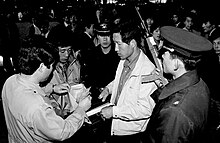| This article may need to be rewritten to comply with Misplaced Pages's quality standards. You can help. The talk page may contain suggestions. (January 2023) |

Korean citizens are issued a national ID card (Korean: 주민등록증; Hanja: 住民登錄證; RR: jumin deungnokjeung; MR: Chumin tŭngnokchŭng) when they reach the age of 17. This card contains a unique Resident registration number (Korean: 주민등록번호; Hanja: 住民登錄番號; RR: jumin deungnok beonho; MR: chumin tŭngnok pŏnho). The first six numbers indicate the citizen's date of birth, in the format YYMMDD, for example, someone born on August 15, 1980, would have 800815 as the first six digits. The last seven numbers includes information such as where the birth was registered. This resident registration number is used by Korean citizens and foreign nationals for all forms of record-keeping.
History
'Identity card' in the history of Korea
In Korea, the first Identity Card appeared in the Joseon Dynasty, it was called Hopaebeop (호패법). Joseon Dynasty, which had a centralized national government, it was necessary to have an ID card for all people to effectively maintain the class system, After that The Korea Empire which succeeded Joseon Dynasty made the first modern ID cards. Since the current identity card system was made in the Republic of Korea period, following World War II and Korea's independence from the Japanese Empire.
'Citizenship certificate' the forerunner of 'Identity card'
With the outbreak of the Korean war, there was a need to distinguish between legal residents and enemy spies. Thus the first Residents ID card was issued in 1950. On that card, detailed personal information such as address, and occupation, as well as weight, blood type, etc. were written to fit the special circumstances of wartime.
The first ID card

Social Security numbers have its origins in the social security legislation in 1962. At that time its dual enrollment to citizens and residents was available so it was not performed properly. Then in 1968, after the ‘Kim Shin -jo incident’, when North Korean special forces stormed The Blue House, it amended the Social Security Act because Spy identifies were given a number to each citizen.
Social security number at the time consisted of 12 digits. In November 21, it was issued by former President Park Chung-hee identity card No. 1 to No. 110101-100001, and Mrs. Yuk Young-soo, was issued a second call to a number 110101-200002. At this time the front row was made with a number of regional issues, the back had been issued Order.
The beginning of the current 13-digit social security number
It is a 13-digit number such as this was written in 1975. Front row was the combination of date of birth, gender and birth backseat area, It was held a little more privacy than before. At this time there began to arise regulations that must be presented if the police officer asked.
Configuration
Overall Components
In current Resident Registration Act, ID card must be mounted name, ID photo, fingerprint, published date and resident registration agency. But if the resident wants applicating blood type, it can be applicated on the basis of Presidential Decree. (2 of Art. 14 of the Residents Registration Law)
Holographic anti-forgery
There is a Taegeuk(태극) shape on the left, and an image of a globe showing the Pacific Rim in the bottom center. The phrase "대한민국" (Republic of Korea) is written in a crescent shape.
Status of ID card issued
Issuance
In Resident Registration Act, mayor, Supervisor, Alderman shall issue to 17-ages-old who jurisdictions residents. The person who aged 17-years-old must proposes of ID card issued to Act, mayor, Supervisor. (3 of Art. 24 of the Residents Registration Law) The ID card is issued by computerized resident information center of the Ministry of Public Administration and Security, at the request of the Mayor, Supervisor, Alderman, and it has been grant and delivered to City. (1 of Art. 28 of the Residents Registration Law) If it lost or damaged, the name or date of birth or gender changed, insufficient of ID card entry column, difficult of identification by changed the face or etc., that time replacement of ID card. (3 of Art. 40 of the Residents Registration Law) In this time, People who have an identity card is 40 million people, and it is estimated that about 350 million per year issuance.
Usage
ID card is estimated that is used more than hundreds of thousands of cases a day. Usually more than 60% get the description from the financial institutions are using this ID card, and it is also used on ARS or Online Applications amounts to about 10 million per day.
See also
References
- ^ "주민등록법". Government of Korea. May 29, 2016. Retrieved June 22, 2016.
제24조(주민등록증의 발급 등) ① 시장·군수 또는 구청장은 관할 구역에 주민등록이 된 자 중 17세 이상인 자에 대하여 주민등록증을 발급한다.
- ^ "대한민국 국민임을 증명하는 주민등록증의 역사". November 20, 2014.
- ^ "주민등록증에 나온것이 맞는지, 위조는 아닌지 진위확인하는 방법이 있나요?".
- ^ "박정희, 둘리, 하니의 주민등록번호는? 주민등록번호의 역사". August 7, 2014.
External links
- 'Proving that the Republic of Korea citizens History of ID card' Written by NATIONAL MUSEUM OF KOREA CONTEMPORARY HISTORY
- 'History of the Social Security Number' Written by Korea Times
| National identity cards | |||||
|---|---|---|---|---|---|
| Africa | |||||
| Asia | |||||
| Europe |
| ||||
| North America | |||||
| South America | |||||
| Non-biometric identity cards ( | |||||